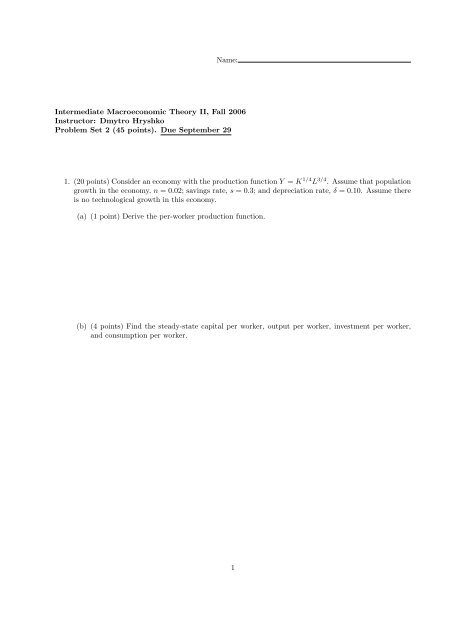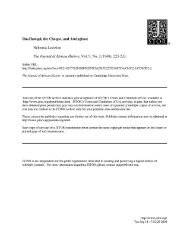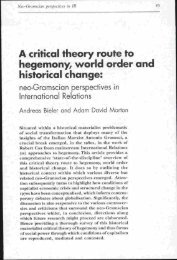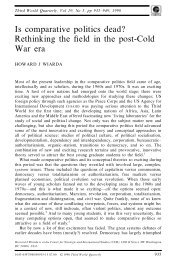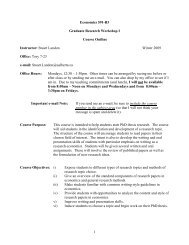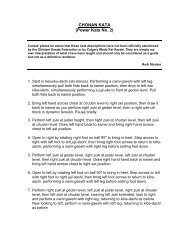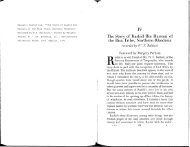Dmytro Hryshko Problem Set 2 (45 points). Due September 29 1.
Dmytro Hryshko Problem Set 2 (45 points). Due September 29 1.
Dmytro Hryshko Problem Set 2 (45 points). Due September 29 1.
- No tags were found...
You also want an ePaper? Increase the reach of your titles
YUMPU automatically turns print PDFs into web optimized ePapers that Google loves.
Name:Intermediate Macroeconomic Theory II, Fall 2006Instructor: <strong>Dmytro</strong> <strong>Hryshko</strong><strong>Problem</strong> <strong>Set</strong> 2 (<strong>45</strong> <strong>points</strong>). <strong>Due</strong> <strong>September</strong> <strong>29</strong><strong>1.</strong> (20 <strong>points</strong>) Consider an economy with the production function Y = K 1/4 L 3/4 . Assume that populationgrowth in the economy, n = 0.02; savings rate, s = 0.3; and depreciation rate, δ = 0.10. Assume thereis no technological growth in this economy.(a) (1 point) Derive the per-worker production function.(b) (4 <strong>points</strong>) Find the steady-state capital per worker, output per worker, investment per worker,and consumption per worker.1
(c) (1 point) What is the growth rate of output per worker, capital per worker, and consumption perworker in the steady state?(d) (1 point) What is the growth rate of total output, total consumption, and total capital in thesteady state?(e) (1 point) Compute the share of labor and capital income in total GDP.2
(f) (3 <strong>points</strong>) Compute the golden rule level of capital per worker for this economy.(g) (3 <strong>points</strong>) Compute the golden rule savings rate for this economy. Is it different from the currentsavings rate in the economy?3
(h) (1 point) Based on your answer to (1g), is the economy over-saving or under-saving?(i) (3 <strong>points</strong>) Now assume another economy, similar in all respects to our original economy, buthaving the population growth n = 0. Compute the steady state consumption per worker, outputper worker, and consumption per worker relative to their respective steady state values in theeconomy with the population growth rate n = 0.02.(j) (2 <strong>points</strong>) What is the growth rate of total output in the economy with the population growth of0%? In which economy the average worker is better off?4
2. (10 <strong>points</strong>) (<strong>Problem</strong> 5, p. 107) One view of the consumption function, also consistent with evidenceon savings from household data, is that workers have high propensities to consume and capitalists(entrepreneurs) have low propensity to consume. Using this observation, suppose that an economyconsumes all wage income and saves all capital income. Show that if the factors of production earntheir marginal products, this economy reaches the golden rule level of capital. (Hint: Begin with thedefinition of capital income, and use the condition that it earns its marginal product. Use the identitythat savings are equal to investment and the steady state condition that investment is just enough tokeep up with depreciation and population growth.)3. (7 <strong>points</strong>) Indicate, for each of the statements below, whether it is true or false. Briefly explain,supporting your answer with formulas and/or graphs.(a) (2 <strong>points</strong>) (Solow Growth Accounting) Writing the CRS production function in terms of capitaland effective labor (i.e., as Y = F (K, E × L), where E is the level efficiency per worker) impliesthat as the level of technology increases by a certain percentage, the number of workers requiredto achieve the same level of output decreases by the same percentage. (Hint: If you find it hardto see this for a general function, use some CRS function like Y = K 1/2 (L × E) 1/2 . For a generalproof, use steps we have done to arrive at the growth accounting formula.)5
(b) (1 point) With the labor-augmenting technological progress, in the steady state, output per effectiveworker grows at the rate of population growth.(c) (1 point) With the labor-augmenting technological progress, in the steady state, output per workergrows at the rate of technological progress.(d) (2 <strong>points</strong>) A higher saving rate implies a higher level of capital per effective worker in the steadystate, and thus a higher rate of growth of output per effective worker in the steady state.(e) (1 point) (AK model) For endogenous growth model we discussed in class, if s × A = δ, a highersaving rate could lead to the growth of output forever.6
4. (8 <strong>points</strong>) Suppose that a massive government program places workers to the jobs that match theirskills the best. As a result of the program, efficiency level of existing workers doubles. Also supposethat the rate of technological growth, g, and the rate of population growth, n, stay the same.(a) (2 <strong>points</strong>) What is the immediate effect of the program on the capital per effective worker, andoutput per effective worker?(b) (2 <strong>points</strong>) In the new steady state, will the capital per effective worker ultimately move towardsits old steady state level or not? Why?(c) (2 <strong>points</strong>) In the new steady state, what is the growth rate of output and output per worker?(d) (2 <strong>points</strong>) Will the output per worker be larger in the new steady state than in the steady statebefore the government intervention? Explain.7


